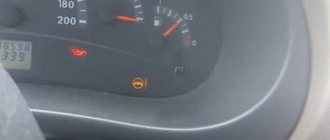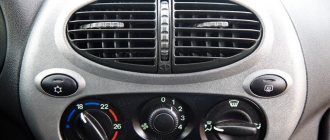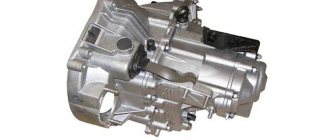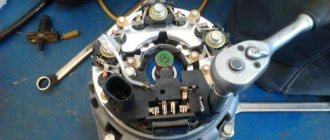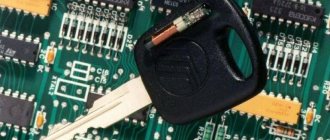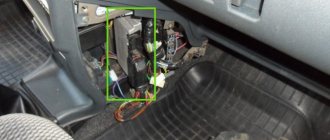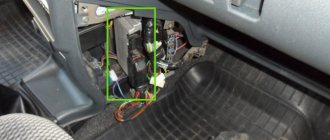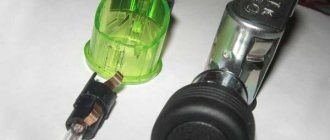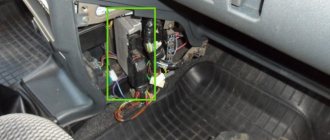Electric power steering is a component used to provide more comfortable driving. Not so long ago, domestically produced cars began to be equipped with EUR, in particular, in this article we will talk about Lada Kalinas. What malfunctions can occur with the Kalina EUR and what troubleshooting methods are there? Find answers to these and other questions below.
Causes of EUR failure
Why does the electric power steering on the Lada Kalina not work, turns off and refuses to work, what are the signs of a steering wheel with power steering knocking, jamming, biting or squeaking? To repair the system yourself, you need to know how diagnostics are carried out and what causes precede the breakdown. Most often, the failure of the amplifier is caused by a breakdown of the unit itself and the amplifier fails. Problems of this type are resolved by thoroughly checking the system to identify the exact problem.
As practice shows, often the inoperability of the electric amplifier (failure) is associated with a breakdown of the speed controller.
Consequences:
- the steering wheel is jammed,
- jams
- becomes tight
- and others
Because the speed controller sensor ensures activation and deactivation of the electric power steering under different driving modes. The amplifier on Kalina works if the car is moving at low speed. When the speed begins to increase, the booster automatically turns off, allowing for safer machine control when driving at high speeds.
So, briefly about the reasons for the inoperability of the EUR:
- The speed controller has failed or the control unit does not receive or disappears a signal from it. In this case, the reason may lie in either a breakdown of the sensor, damaged wiring, or poor contact of the controller with the on-board network.
- The voltage in the vehicle's electrical network has decreased. The reasons can be different, ranging from a dead battery and an inoperative generator to the use of inappropriate electrical equipment in the car.
- The permissible crankshaft speed has been exceeded.
- Incorrect operation or failure of the control module. Depending on the cause, the control unit may need to be repaired; more detailed diagnostics need to be done.
Wiring diagram of the rear harness Lada Kalina
Connections of the rear harness of the car: 1 - rear harness block to the instrument panel; 2 — block to the wiring harness of the left front door; 3 - to the rear door wiring harness; 4 — right lamp; 5 - to the rear door wiring harness; 6 — to the tailgate wiring harness; 7 - to the instrument panel; 8 — lampshade; 9 — left side direction indicator; 10 — fuel level indicator sensor; 11 — reverse lock switch; 12 - to the right front door; 13 — parking brake sensor; 14 — trunk light; 15 — double-glazed window control unit; 16 — right direction indicator; 17 — left lamp; 18 - to the tailgate
Diagnostics
To check the amplifier in a car, you need to remove the plastic trim on the steering column; to do this, unscrew the bolts securing it from the bottom.
Then you will need to get to the 8-pin plug, its pinout is as follows:
- The blue contact is connected to the ignition switch, this is 12 volt power;
- the red-brown contact is the connection cable to the tachometer;
- the gray contact goes to the car speed controller;
- white and pink wire - amplifier control indicator;
- black-yellow contact is a diagnostic line;
- the next contact is empty, the wire is not connected to it;
- brown contact is ground;
- empty.
More accurate results will be obtained by checking the amplifier using a scanner. But since such equipment can usually only be found at service stations, you can try to check the operation of the system with a paper clip.
To check you need to do the following:
- First the ignition is turned off.
- Then, using a paper clip, you need to close contacts numbered 6 and 7 of this plug, while the plug itself does not need to be removed.
- Next, the ignition must be turned on.
- After completing these steps, the EUR failure indicator located in the dashboard will begin to blink; by the number of blinks, you can determine whether the system is broken (the author of the video is Gosha Vakhromeev).
How to understand where to look for the cause by the blinking indicator icons:
- one long signal and one short signal - the electric amplifier is working;
- one long and two short - no engine speed signal;
- one long and three short - the torque controller is out of order or there is no power supply;
- one long and four short blinks—problems in the operation of the electric power steering motor;
- one long and five short - the steering shaft position controller has failed;
- one long and six short - the motor rotor position controller has failed;
- one long and seven short - problems with the electrical network - the voltage is either too high or very low;
- one long and eight short - the control module of the electric amplifier has failed;
- one long and nine short - the speed controller is broken.
Error codes
c1044 - incorrect sequence of the rotor position sensor (RPS)
c1621 - incorrect voltage 5V
c1622 - speed signal circuit failure
c1011 - car engine speed signal circuit, no signal - the signal from the idle sensor (or the standard tachometer through a voltage limiter) is divided by 4 and applied to the tachometer input,
c1022 - error, voltage of the main output of the torque sensor - it is possible that the shaft cover has rubbed the insulation and the middle, green wire shorts to ground
Signs of a faulty car air conditioner bearing
The main symptom is extraneous noise, a hum when starting the engine. It may be intermittent and appear only before or after the engine warms up. When you turn on the car air conditioner, the noise may disappear.
How to understand that it is the compressor bearing that is humming?
The volume of the hum gradually increases . If at first it is barely audible, then after 1-2 thousand kilometers (or less) it becomes clearly visible. Gradually the hum becomes quite loud. How quickly it will increase depends on the degree and speed of wear and operating conditions. With a humming bearing you can travel 5 thousand km, but you may not even last 500 km.
The operation of attachments affects the hum (if the compressor does not have a separate belt). This is best seen from the power steering. If you turn the wheels left and right while the car is stationary (or driving at low speed), the noise will change, become louder, a little higher.
Sound source . If you open the hood with the engine running, it is easier to identify the sound source even with a dense arrangement in the engine compartment. If it comes from the area where the electromagnetic clutch is installed and the pulley is located, most likely it is the air conditioner bearing that is making noise. If it is visible, you can pay attention to how it rotates: twitching, noticeable vibration indicate serious wear.
The appearance of a rumble, a very loud hum . Occurs when the bearing is heavily worn, when it can jam at any moment. It is better to turn off the engine and tow it to a car service center or call a tow truck. If there is a separate belt for the compressor, you can cut it and go to the service center yourself.
If extraneous hum and noise appears only when the air conditioner is turned on while the engine is running, the malfunction is not related to the bearing. Most likely the problem is in the compressor housing.
The appearance of a hum from a bearing is due to a lack of lubrication, water, dirt, and dust getting inside. When rotating without lubrication, it overheats (the heating temperature may exceed the limit values set by the factory), and the load increases. If you do not replace it, the heated balls inside will break the separator and jamming will occur. When removing a worn bearing, a blue tint is visible on the cage, which indicates overheating.
Jamming of the car air conditioner bearing leads to belt breakage. If the belt is used for attachments (generator, pump, power steering, etc.), it stops working. If the belt breaks in the engine compartment, the most serious damage is possible: broken wiring, impacts on individual parts, and their breakage. If the belt bounces upward, it can bend the inside of the hood at the point of impact (it forms a “hump”). The compressor also fails and has to be replaced. A jammed bearing can begin to rotate in the seat, forming a recess of up to several mm, creating vibration that disables the generator, pump, and other equipment.
Dismantling and disassembling the electric amplifier
Before removing the amplifier, you need to remove all the steering column switches. Remove the steering rack cover and dismantle the devices, remembering to disconnect the connectors from the power supply.
How to remove the EUR with your own hands:
- After removing the switches, you will need to dismantle the lower cross member of the dashboard. To do this, you need to press the fasteners that secure the connector with wires, and then disconnect the wiring from the control module. Once these steps are completed, you can disconnect the connector from the switches.
- The system bracket is secured with nuts; you will need to unscrew them with a wrench.
- After this, the steering rack will need to be carefully lowered down. To do this, you will need to find the bolt that secures the driveshaft to the booster shaft. This bolt must be unscrewed, but when unscrewing, you will need to fix the nut, this will prevent it from turning. When the bolt is removed, the fastening will need to be loosened, after which the intermediate shaft will be carefully removed. At this stage, we recommend marking the position of the shaft and gears; you can use a marker for this. This step is very important because doing it will prevent possible installation problems in the future. If the marks on the shafts do not match, this may cause problems with the amplifier. When dismantling, be careful not to damage the wiring, as this will also lead to the inoperability of the ESD.
- When the unit is dismantled, it will need to be disassembled and the failed elements replaced. Further editing is done in reverse order (the author of the video is Murzik Bely).
Choosing the right radiator: the key to its flawless operation
If you need to install a new stove on a Lada Kalina car, you need to choose this part correctly, focusing on the following criteria:
- the material from which the product is made. Aluminum devices are less expensive, but they have one significant drawback - if cracks or other defects appear, replacing the radiator is not possible. You can throw it away immediately without wasting time. Therefore, it makes sense to purchase, albeit expensive, but reliable and repairable copper-brass part;
- the presence of coolant swirlers, which are made of high-quality plastic. Radiators with such elements work much more efficiently and become less clogged.
How to tighten the electric power steering rack?
The appearance of a knocking sound in the operation of the electric power steering is associated with the need to tighten the steering rack.
How to do it right:
- First you need to disconnect the battery; to do this, disconnect the terminals from it. Unscrew the battery mount; to do this, you need to unscrew two more nuts located at the edges. After this, the battery is removed and put aside.
- Then you need to lift the plastic stand, there are four more screws under it, they can also be unscrewed.
- Having done this, it is necessary to move this stand forward until the platform is disconnected from the air filter housing retainer pad. After this, the trim can be moved back, this will provide freer access to the rail itself.
- At the next stage, you will need to crawl your hand under the rail. Directly below it, as shown in the photo, there is a rubberized cap; it will need to be removed, this will allow the key to access the adjusting nut.
- To perform adjustment work, you will need a special wrench to tighten the rack; without it, the adjustment procedure will not be possible. Using this wrench, you need to crawl under the car rail to install the tool in the required hole.
- When adjusting, be careful not to overtighten the rack. If its tightening is very strong, then when cornering the rack will bite, and this, in turn, may affect the safety of movement. The angle of adjustment is always different, it depends on how much the nut is loose, but usually when performing such work the nut is tightened by approximately 30 degrees. This should be enough to get everything right. After the adjustment is completed, it will be necessary to check that this task was performed correctly. That is, you will need to make sure that the steering wheel turns normally to any position all the way and there is no knocking. If the knock remains, then the adjustment continues.
Photo gallery “Adjusting the steering rack”
1. Slide the stand and detach it.
2. In this place under the rail there is an adjusting washer.
3. Adjustment is made with a special key.
4. Location of the adjusting nut.
Power steering (hydraulic system)
It’s worth starting with this option, because it was the first to appear on cars and has still not lost its relevance.
Operating principle : Very simple, here the main working fluid is a special fluid, often ATF , which is poured into the automatic transmission of the car . The steering rack itself is a hollow cylinder into which a piston goes, attached to the steering shaft (to exaggerate it, it looks very much like a pharmaceutical syringe). A special pump pumps oil pressure in one direction or the other, and this piston begins to deviate in one direction or the other, accordingly helping you turn the steering wheel. There is approximately 0.5 - 1 liter of oil in the system, it is pumped by a pump that is driven by the engine crankshaft, that is, they are connected by a belt drive. Of course, the system contains metal and rubber tubes through which the working fluid actually pumps.
Due to the rigid connection, the motor power is reduced, because part is simply eaten by the pump!
A few words about EGUR . That's why electric power steering is now starting to appear. What does it mean? The differences are few, but they are significant - here, instead of a belt pump, an electric motor is used, that is, electricity is simply supplied and it pumps oil in the system. Thus, taking much less power and saving up to 0.5 - 0.7 liters per 100 km. Well, now it’s time to think about the pros and cons of this device
Pros of GUR
- Controllability. The driver has good feedback from the road; in terms of response accuracy and response, power steering comes first
- Great effort. Such amplifiers are installed on many HEAVY trucks; all electrical systems are not yet fully adapted
- Comfortable handling at both low and high speeds
- Now there are new generation devices with electric pumps that do not use a belt drive and save fuel
- There are no complex electronic sensors, we can call this system analog (except for power steering)
- Reliability is at a fairly high level; if you take care and change the oil in the system , it can last a very long time
In general, there are not many complaints about this system; it still works stably, accurately and, importantly, can “turn” heavy truck racks. However, there are also a lot of negative aspects
Cons of GUR
- Takes up quite a lot of space under the hood (pipes, pump, rack itself) all this is quite cumbersome
- It has a special oil that needs to be changed after a certain number of kilometers, otherwise it may break down. Because oil seals can wear out faster
- If the model is old (belt), it increases fuel consumption by up to 10% (if compared with the opponent). Because it additionally creates a load on the engine (pressure is built up thanks to a belt drive that comes from the crankshaft, respectively, part of the engine energy is spent on the hydraulic booster). Even at idle
- At low temperatures, you need to use it more carefully, it is advisable to warm it up together with the motor
- If there is a leak or oil has leaked out, then you cannot operate the car! Or very limited mileage. Otherwise, the pump itself that pumps the oil may break.
- Repairs are sometimes very expensive. Although almost all service stations do this, there is nothing particularly complicated here
How can I lubricate and adjust the EUR?
How and with what to lubricate the amplifier?
Litol can be used as a lubricant; the procedure is performed as follows:
- First you need to remove the plastic casing; to do this, unscrew the bolts that secure it. To unscrew, use a Phillips head screwdriver. It is also advisable to remove the lower cross member of the instrument panel, located under the steering wheel.
- Next, unscrew the two bolts that secure the amplifier itself; for this you will need a 13mm wrench. After this, the column can be released down.
- Unscrew another bolt, after which you can do the actual lubrication.
- First, the steering wheel is turned to the left until it stops. The lubricant is poured into a 10 cc syringe, which needs to be sprayed into the hole formed. You need to throw out all 10 cubes.
- Then the steering wheel is turned to the right until it stops - the syringe is again directed into the hole, all the lubricant is sprayed out.
- After this, the steering wheel should be turned to the middle position and again sprinkled with lubricant into the hole.
- Next, the steering wheel must be turned in different directions until it stops several times. The lubrication operation is repeated again.
- Then all the components are assembled in reverse order.
Preparing to replace the heater
It is recommended to start work on your own only if you have a garage and a set of tools. Complete disassembly and assembly of the front panel will take the whole day; the simplified method will require at least 3 hours. Tool for work:
- a good set of screwdrivers and wrenches;
- set of heads for 7,8,10,13;
- pliers;
- hacksaw for metal;
- sharp knife;
- Bulgarian;
- reinforced hoses with a diameter of 20 mm;
- container and hose for draining coolant;
- new radiator.
There should be good lighting at the workplace, and during disassembly it will be convenient to put all small parts in separate boxes. After the engine has cooled down a little, begin replacing the heater radiator. This is possible in two ways: by removing the entire panel and by partially disassembling and cutting off the wall of the heater housing.
Attention! You should not pour special sealing compounds into the cooling system. Together with a small leak, they are highly likely to clog the narrow channels of the stove radiator.
Electric power steering connection diagram with icons
Lada Kalina 1117 2004 – 2012
Lada Kalina air conditioner bearings guarantee reliability, controllability, mobility and safety of your car on the roads. Original and branded spare parts are always available in warehouses at reasonable prices.
However, speaking of repairs, even more important for driving safety is regular maintenance and timely repairs, subject to vehicle maintenance regulations:
- works well,
- does not lose its performance over long runs,
- more reliable and safer to operate
We make it easy to keep your car in good condition and provide great deals on our entire range of parts. Everything you need for service and repair can be found right here in our digital warehouses. Instead of endlessly searching for a retail auto parts store near you that doesn't necessarily have the parts you need, just pick up the phone and we'll deliver the auto parts you need to your door.
The main emphasis when selecting spare parts is based on the company’s experience.
It is profitable and safe to buy from us for a number of main reasons:
- Autocompas.ru is one of the leading online stores of auto parts, with daily traffic on the site of more than 30,000 people,
- Certified and reliable suppliers provide a full range of auto parts within access to their warehouses,
- The system has more than 500 suppliers and manufacturers who regulate prices with an eye on competitors and strive to make their goods more profitable to purchase.
VAZ 21126 (1.6-16cl):
This engine is completely new and there is very little information on it, as it turned out the first drawback in it: like a 16 valve engine, if the timing belt breaks, it bends the valves, perhaps it will transfer some of the sores from the 1.4 16kl engine.
Recent Entries
BMW 530e Hybrid revised for 2022
The BMW 530e PHEV has been updated with a new battery, improved efficiency, lower emissions and increased electric power range. The hybrid BMW 530e was
Watch a plane crash land on a public road, caught on police dash cam
Starman Adventures Is a Big Hit Among Teslas - SpaceX Fans
New deal offers drivers a free car - life-saving brakes for drivers up to £1,600
Categories
Test Drive
Ferrari Portofino 2019 review
Ferrari Portofino. this is a super stallion that you will ride every day Maximums Spectacular gearbox with excellent shift mechanics
Choice of consumables: classic or coal?
Please note that there are two types of filtration systems:
Most car owners recommend a carbon cabin filter, since it is characterized by the presence of two dense layers of synthetics, between which a carbon absorbent is located. It effectively traps dust and other small particles so that they do not enter the cabin. This is especially true in large cities and megalopolises, where the level of air pollution is simply off the charts.
